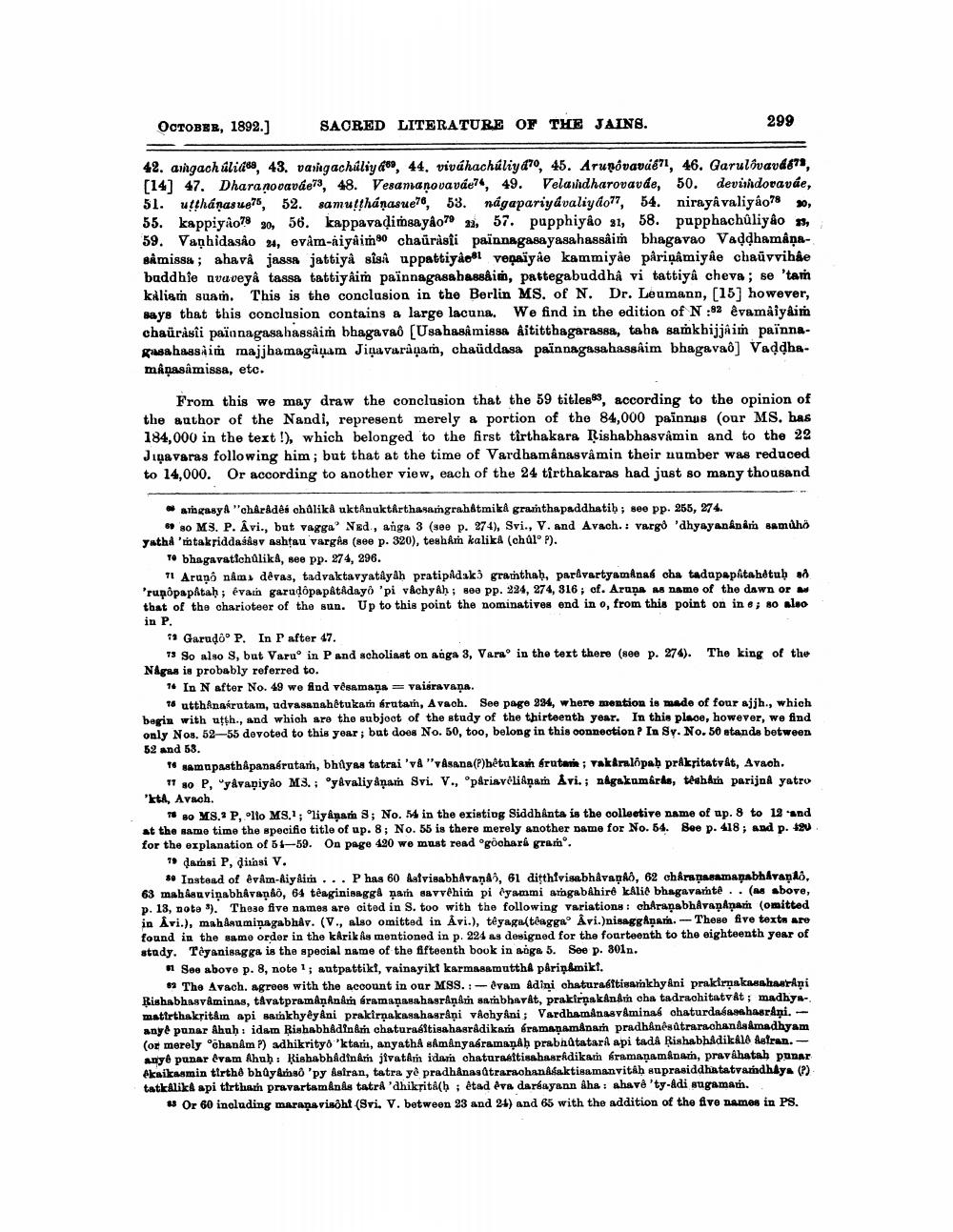________________
299
OCTOBER, 1892.]
SACRED LITERATURE OF THE JAINS.
42. amgachúliás, 43. vangachuliya, 44, viváhachúliyd70, 45. Arunovavaé71, 46. Garulovavá67, [14] 47. Dharanovaváe73, 48. Vesamanovaváe7, 49. Velandharovavde, 50. devidovaváe, 51. utthanasue75, 52. samutṭhánasue76, 53. nágapariyávaliyao77, 54. niraya valiyâo78 30, 55. kappiyao78 20, 56. kappavaḍimsayAo70 33, 57. pupphiyão 31, 58. pupphachûliyâo, 59. Vanhidasão 24, evam-aiyaim 80 chauràsîi païnnagasayasahassâim bhagavao Vaddhamâna-. samissa; ahava jassa jattiyà sisa uppattiyae venaïyae kammiyae pârinâmiyâe chauvvihâe buddhie avaveyâ tassa tattiyâim païnnagasahassâim, pattegabuddhâ vi tattiyâ cheva; se 'tam kaliam suam. This is the conclusion in the Berlin MS. of N. Dr. Leumann, [15] however, says that this conclusion contains a large lacuna. We find in the edition of N :92 êvamaiyaim chauràsîi païnnagasahassaim bhagavao [Usahasâmissa Aititthagarassa, taha samkhijjaim païnnagasahassaim majjhamagauam Jinavaranam, chaüddasa païnnagasahassâim bhagavaô] Vaddhamânasâmissa, etc.
From this we may draw the conclusion that the 59 titles, according to the opinion of the author of the Nandi, represent merely a portion of the 84,000 painnus (our MS. has 184,000 in the text!), which belonged to the first tirthakara Rishabhasvamin and to the 22 Jinavaras following him; but that at the time of Vardhamânasvâmin their number was reduced to 14,000. Or according to another view, each of the 24 tirthakaras had just so many thousand
amgasya "chârâdês châlika ukt nuktarthasaṁgrahatmika gramthapaddhatiḥ; see pp. 255, 274.
30 M3. P. Âvi., but vagga Ned., anga 3 (see p. 274), Svi., V. and Avach.: vargo 'dhyayanānāṁ samûhö yatha 'mtakriddasåsv ashțau vargês (see p. 320), tesham kalika (chúl° P).
To bhagavatichûlika, see pp. 274, 296.
71 Arupo nâm dêvas, tadvaktavyatâyâh pratipidak3 gramthaḥ, paravartyamânas cha tadupapatahetuḥ så 'rupopapatah; évain garuḍôpapâtâdayo 'pi vâchyah; see pp. 224, 274, 316; cf. Aruna as name of the dawn or as that of the charioteer of the sun. Up to this point the nominatives end in o, from this point on in e; so also in P.
73 Garudo P. In P after 47.
73 So also S, but Varu° in P and scholiast on anga 3, Vara" in the text there (see p. 274). The king of the Nagas is probably referred to.
14 In N after No. 49 we find vêsamana = vaisravana.
76 utthanasratam, udvasanahêtukam érutam, Avach. See page 234, where mention is made of four ajjh., which begin with utth., and which are the subject of the study of the thirteenth year. In this place, however, we find only Nos. 52-55 devoted to this year; but does No. 50, too, belong in this connection? In Sy. No. 50 stands between 52 and 53.
16 samupasthapanaératam, bhûyas tatrai 'vå "vasana (P)hêtukam érutane; vakaralopaḥ prikritatvåt, Avach.
17 so P, "yavaniyao M3.; "yavaliyanam Svi. V., pâriavėliapam Avi.; nagakumárás, têshim parijna yatro 'kti, Avach.
78 80 MS.3 P, olio MS.1; liyanam 8; No. 54 in the existing Siddhanta is the collective name of up. 8 to 12 and at the same time the specific title of up. 8; No. 55 is there merely another name for No. 54. See p. 418; and p. 420 for the explanation of 51-59. On page 420 we must read "göchará gram.
7 damsi P, dinasi V.
se Instead of evam-Aiydim... P has 60 Astvisabhavana, 61 ditthivisabhavano, 62 chârapasamanabhavando, 63 mahasuvinabhavanâo, 64 têaginisagga nam savvêhim pi yammi amgabahirê kaliê bhagavatê (as above, p. 13, note 3). These five names are cited in S. too with the following variations: charanabhavaniņam (omitted in Avi.), mahasuminagabhav. (V., also omitted in Avi.), têyaga(têagga Avi.)nisaggAnam. These five texts are found in the same order in the kârik As mentioned in p. 224 as designed for the fourteenth to the eighteenth year of study. Teyanisagga is the special name of the fifteenth book in anga 5. See p. 301n.
1 See above p. 8, note 1; autpattiki, vainayiki karmasamuttha pârinamiki.
82 The Avach. agrees with the account in our MSS.:-êvam adini chaturaéftisamkhyani prakirnakasahasrani Rishabhasvaminas, tâvatpramAnAnam éramanasahasranam sambhavat, prakirṇakânâm cha tadraohitatvât; madhya-. matirthakritâm api samkhyêyani prakirṇakasahasrani vachyâni; Vardhamânas váminaé chaturdasasahasranņi. - anyê punar Ahuh: idam Rishabhâdinâm chaturaéltisahasrádikam éramanamanaṁ pradhanêsûtrarachanâsâmadhyam (or merely chanâm ?) adhikritys 'ktam, anyatha sâmânyaéramanah prabhûtatara api tada Rishabhâdikale Asfran.anyê punar evam Ahub: Rishabhâdînám jivatâm idam chaturaeitisahasradikaṁ framanamanam, pravahatah punar ékaikasmin tirthe bhûyamso 'py Asiran, tatra yê pradhanasûtraraohanâfaktisamanvitáḥ suprasiddhatatvamdhaya (?) tatkalika api tirtham pravartamânâs tatra 'dhikṛita(b; êtad éva daréayann âha: ahavê 'ty-adi sugamam.
3 Or 60 including marana visõht (Svi. V. between 23 and 24) and 65 with the addition of the five names in PS.




